
Illustrative Math Alignment: Grade 8 Unit 3
Linear Equations and Linear Systems
Lesson 1: Number Puzzles
Use the following Media4Math resources with this Illustrative Math lesson.
| Thumbnail Image | Title | Body | Curriculum Topic |
|---|---|---|---|
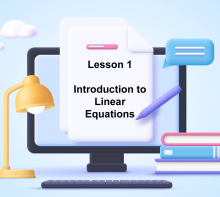
|
Lesson Plan--Linear Functions and Equations (MS)--Lesson 1--Introduction to Linear Equations | Lesson Plan: Introduction to Linear EquationsThis lesson is the first in a five-part series on linear equations for middle school students. It introduces the fundamental concepts of linear equations, their structure, and their applications in real-world contexts. |
Slope-Intercept Form and Standard Form |

|
Lesson Plan--Linear Functions and Equations (MS)--Lesson 3--Solving Linear Equations | Solving Linear EquationsThis is the third lesson in a five-part series on linear equations for middle school students. In this lesson, students develop skills to solve one-variable linear equations using inverse operations, balancing equations, and verifying solutions. They will learn to solve equations with one solution, no solution, or infinitely many solutions. The lesson aligns with Common Core Standards 8.EE.C.7 and 8.EE.C.7a. |
Solving One-Step Equations and Solving Two-Step Equations |
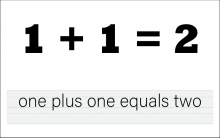
|
Math Clip Art--The Language of Math--Numbers and Equations 01 | Math Clip Art--The Language of Math--Numbers and Equations 01TopicThe Language of Math DescriptionThis image from the Language of Math collection illustrates the equation "1+1=2" using both numerical symbols and words. It serves as a fundamental building block in teaching basic addition and the concept of equality in mathematics. By presenting the equation in both numerical and verbal forms, this clip art reinforces the connection between mathematical symbols and their linguistic representations. This dual presentation is crucial for developing students' ability to translate between mathematical language and everyday language. |
Numerical Expressions |
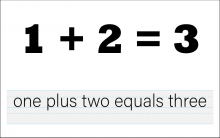
|
Math Clip Art--The Language of Math--Numbers and Equations 02 | Math Clip Art--The Language of Math--Numbers and Equations 02TopicThe Language of Math DescriptionThis clip art image from the Language of Math series depicts the equation "1+2=3" in both numerical and word form. It builds upon the previous image, introducing the concept of adding a two-digit number to a one-digit number. The visual representation of this equation helps students understand how numbers combine to form larger values. By presenting the equation in both formats, it reinforces the connection between mathematical symbols and their verbal expressions, a crucial skill in mathematical literacy. |
Numerical Expressions |
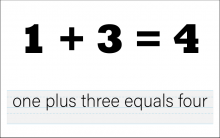
|
Math Clip Art--The Language of Math--Numbers and Equations 03 | Math Clip Art--The Language of Math--Numbers and Equations 03TopicThe Language of Math DescriptionThis clip art from the Language of Math collection presents the equation "1+3=4" in both numerical and word formats. It continues the progression of addition concepts, now introducing the sum of four. The dual representation of the equation reinforces the connection between mathematical symbols and their verbal counterparts. This visual aid helps students understand how numbers combine to create larger values and introduces the concept of "one more than" the previous equation. |
Numerical Expressions |
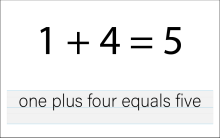
|
Math Clip Art--The Language of Math--Numbers and Equations 04 | Math Clip Art--The Language of Math--Numbers and Equations 04TopicThe Language of Math DescriptionThis clip art image from the Language of Math series illustrates the equation "1+4=5" in both numerical and word form. It continues the pattern of increasing sums, now reaching five. The dual representation of the equation helps students connect the abstract mathematical symbols with their concrete verbal expressions. This visual aid is crucial in developing number sense and understanding the concept of addition, particularly how combining smaller numbers results in larger ones. |
Numerical Expressions |
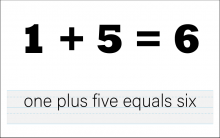
|
Math Clip Art--The Language of Math--Numbers and Equations 05 | Math Clip Art--The Language of Math--Numbers and Equations 05TopicThe Language of Math DescriptionThis clip art from the Language of Math collection showcases the equation "1+5=6" in both numerical and word formats. It continues the series of addition equations, now introducing the sum of six. The simultaneous presentation of the equation in symbols and words reinforces the connection between mathematical language and everyday language. This visual representation helps students understand how numbers combine to form larger values and introduces the concept of "five more than" the initial number. |
Numerical Expressions |
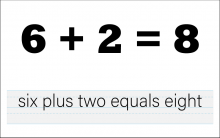
|
Math Clip Art--The Language of Math--Numbers and Equations 06 | Math Clip Art--The Language of Math--Numbers and Equations 06TopicThe Language of Math DescriptionThis image illustrates the equation "6+2=8" in both numerical and word form, continuing the progression of addition concepts with larger numbers. The dual representation reinforces the connection between mathematical symbols and their verbal expressions, a crucial skill in developing mathematical literacy. This visual aid helps students understand how numbers combine to create larger values and introduces the concept of adding to a number greater than 5. |
Numerical Expressions |
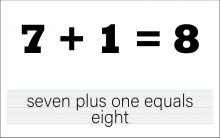
|
Math Clip Art--The Language of Math--Numbers and Equations 07 | Math Clip Art--The Language of Math--Numbers and Equations 07TopicThe Language of Math DescriptionThis clip art from the Language of Math collection showcases the equation "7+1=8" in both numerical and word formats. It continues the series of addition equations, now introducing the concept of adding 1 to a larger number. The simultaneous presentation of the equation in symbols and words reinforces the connection between mathematical language and everyday language. This visual representation helps students understand how numbers combine and introduces the concept of "one more than" a given number. |
Numerical Expressions |
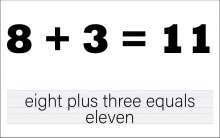
|
Math Clip Art--The Language of Math--Numbers and Equations 08 | Math Clip Art--The Language of Math--Numbers and Equations 08TopicThe Language of Math DescriptionThis image presents the equation "8+3=11" in both numerical and word form, advancing the complexity of addition concepts by introducing a sum greater than 10. The dual representation of the equation reinforces the connection between mathematical symbols and their verbal expressions. This visual aid is crucial in developing number sense and understanding the concept of addition, particularly how combining single-digit numbers can result in double-digit sums. |
Numerical Expressions |
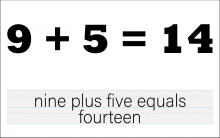
|
Math Clip Art--The Language of Math--Numbers and Equations 09 | Math Clip Art--The Language of Math--Numbers and Equations 09TopicThe Language of Math DescriptionThis clip art from the Language of Math collection illustrates the equation "9+5=14" in both numerical and word form. It continues the progression of addition concepts, now introducing a larger sum and the concept of adding a single-digit number to 9. The dual representation of the equation helps students connect the abstract mathematical symbols with their concrete verbal expressions. This visual aid is crucial in developing number sense and understanding the concept of addition, particularly how combining numbers can result in sums greater than 10. |
Numerical Expressions |
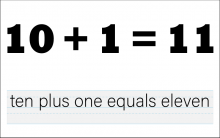
|
Math Clip Art--The Language of Math--Numbers and Equations 10 | Math Clip Art--The Language of Math--Numbers and Equations 10TopicThe Language of Math DescriptionThis image from the Language of Math collection presents the equation "10+1=11" in both numerical and word form. It marks a significant transition in the addition sequence, introducing the concept of adding to a double-digit number. The dual representation of the equation reinforces the connection between mathematical symbols and their verbal expressions. This visual aid is crucial in developing number sense and understanding the concept of addition, particularly how adding to 10 results in the next consecutive number. |
Numerical Expressions |
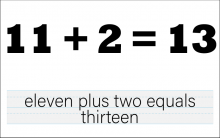
|
Math Clip Art--The Language of Math--Numbers and Equations 11 | Math Clip Art--The Language of Math--Numbers and Equations 11TopicThe Language of Math DescriptionThis image from the Language of Math collection illustrates the equation "11+2=13" in both numerical and word form. It advances the complexity of addition concepts by introducing larger numbers and sums exceeding 10. The dual representation of the equation reinforces the connection between mathematical symbols and their verbal expressions. This visual aid is crucial in developing number sense and understanding the concept of addition, particularly how combining numbers results in sums greater than 10. |
Numerical Expressions |
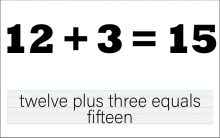
|
Math Clip Art--The Language of Math--Numbers and Equations 12 | Math Clip Art--The Language of Math--Numbers and Equations 12TopicThe Language of Math DescriptionThis clip art from the Language of Math collection showcases the equation "12+3=15" in both numerical and word formats. It continues the progression of addition concepts with larger numbers and sums. The simultaneous presentation of the equation in symbols and words reinforces the connection between mathematical language and everyday language. This visual representation helps students understand how numbers combine and introduces the concept of adding to a number greater than 10. |
Numerical Expressions |

|
Math Clip Art--The Language of Math--Numbers and Equations 13 | Math Clip Art--The Language of Math--Numbers and Equations 13TopicThe Language of Math DescriptionThis image from the Language of Math series presents the equation "13+4=17" in both numerical and word form. It continues the progression of addition concepts with increasingly larger numbers and sums. The dual representation of the equation helps students connect the abstract mathematical symbols with their concrete verbal expressions. This visual aid is crucial in developing number sense and understanding the concept of addition, particularly how combining teen numbers with single-digit numbers results in larger sums. |
Numerical Expressions |
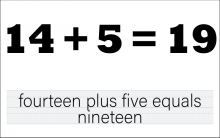
|
Math Clip Art--The Language of Math--Numbers and Equations 14 | Math Clip Art--The Language of Math--Numbers and Equations 14TopicThe Language of Math DescriptionThis clip art from the Language of Math collection illustrates the equation "14+5=19" in both numerical and word form. It advances the complexity of addition concepts by working with larger teen numbers and approaching sums close to 20. The simultaneous presentation of the equation in symbols and words strengthens the connection between mathematical language and everyday language. This visual representation helps students understand how numbers combine and introduces the concept of adding to a number in the teens. |
Numerical Expressions |
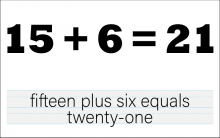
|
Math Clip Art--The Language of Math--Numbers and Equations 15 | Math Clip Art--The Language of Math--Numbers and Equations 15TopicThe Language of Math DescriptionThis image from the Language of Math series depicts the equation "15+6=21" in both numerical and word form. It continues the progression of addition concepts, now introducing sums that exceed 20. The dual representation of the equation reinforces the connection between mathematical symbols and their verbal expressions. This visual aid is crucial in developing number sense and understanding the concept of addition, particularly how combining teen numbers with single-digit numbers can result in sums greater than 20. |
Numerical Expressions |
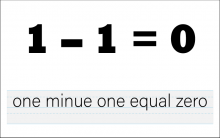
|
Math Clip Art--The Language of Math--Numbers and Equations 16 | Math Clip Art--The Language of Math--Numbers and Equations 16TopicThe Language of Math DescriptionThis clip art from the Language of Math collection illustrates the equation "1-1=0" in both numerical and word form. It introduces the concept of subtraction and the idea of a difference of zero. The simultaneous presentation of the equation in symbols and words reinforces the connection between mathematical language and everyday language. This visual representation helps students understand the basic concept of subtraction and introduces the idea that subtracting a number from itself results in zero. |
Numerical Expressions |

|
Math Clip Art--The Language of Math--Numbers and Equations 17 | Math Clip Art--The Language of Math--Numbers and Equations 17TopicThe Language of Math DescriptionThis image from the Language of Math series presents the equation "2-1=1" in both numerical and word form. It continues the introduction of subtraction concepts, now showing a non-zero difference. The dual representation of the equation reinforces the connection between mathematical symbols and their verbal expressions. This visual aid is crucial in developing number sense and understanding the concept of subtraction, particularly how removing one from a quantity results in a smaller number. |
Numerical Expressions |
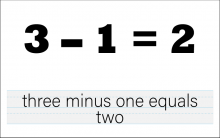
|
Math Clip Art--The Language of Math--Numbers and Equations 18 | Math Clip Art--The Language of Math--Numbers and Equations 18TopicThe Language of Math DescriptionThis image presents the equation "3-1=2" in both numerical and word form. It continues the progression of subtraction concepts, now working with a larger minuend. The simultaneous presentation of the equation in symbols and words strengthens the connection between mathematical language and everyday language. This visual representation helps students understand how subtraction works and introduces the concept of "one less than" a given number. |
Numerical Expressions |
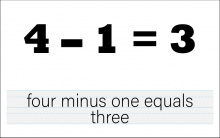
|
Math Clip Art--The Language of Math--Numbers and Equations 19 | Math Clip Art--The Language of Math--Numbers and Equations 19TopicThe Language of Math DescriptionThis image illustrates the equation "4-1=3" in both numerical and word form. It continues the progression of subtraction concepts, now working with a larger minuend. The dual representation of the equation reinforces the connection between mathematical symbols and their verbal expressions. This visual aid is crucial in developing number sense and understanding the concept of subtraction, particularly how removing one from a quantity results in a smaller number. |
Numerical Expressions |
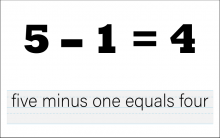
|
Math Clip Art--The Language of Math--Numbers and Equations 20 | Math Clip Art--The Language of Math--Numbers and Equations 20TopicThe Language of Math DescriptionThis clip art from the Language of Math collection showcases the equation "5-1=4" in both numerical and word formats. It continues the series of subtraction equations, now introducing a larger minuend. The simultaneous presentation of the equation in symbols and words reinforces the connection between mathematical language and everyday language. This visual representation helps students understand how subtraction works and introduces the concept of "one less than" a given number. |
Numerical Expressions |
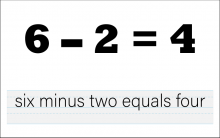
|
Math Clip Art--The Language of Math--Numbers and Equations 21 | Math Clip Art--The Language of Math--Numbers and Equations 21TopicThe Language of Math DescriptionThis image presents the equation "6-2=4" in both numerical and word form. It advances the complexity of subtraction concepts by introducing a subtrahend greater than 1. The dual representation of the equation reinforces the connection between mathematical symbols and their verbal expressions. This visual aid is crucial in developing number sense and understanding the concept of subtraction, particularly how removing multiple units from a quantity affects the result. |
Numerical Expressions |
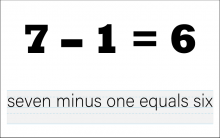
|
Math Clip Art--The Language of Math--Numbers and Equations 22 | Math Clip Art--The Language of Math--Numbers and Equations 22TopicThe Language of Math DescriptionThis clip art from the Language of Math collection illustrates the equation "7-1=6" in both numerical and word form. It continues the progression of subtraction concepts, now working with a larger minuend. The simultaneous presentation of the equation in symbols and words strengthens the connection between mathematical language and everyday language. This visual representation helps students understand how subtraction works and reinforces the concept of "one less than" a given number. |
Numerical Expressions |
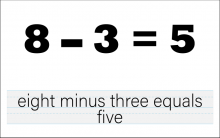
|
Math Clip Art--The Language of Math--Numbers and Equations 23 | Math Clip Art--The Language of Math--Numbers and Equations 23TopicThe Language of Math DescriptionThis image presents the equation "8-3=5" in both numerical and word form. It advances the complexity of subtraction concepts by introducing a larger subtrahend and working with single-digit numbers. The dual representation of the equation reinforces the connection between mathematical symbols and their verbal expressions. This visual aid is crucial in developing number sense and understanding the concept of subtraction, particularly how removing multiple units from a quantity affects the result. |
Numerical Expressions |
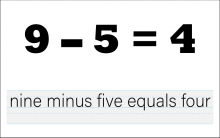
|
Math Clip Art--The Language of Math--Numbers and Equations 24 | Math Clip Art--The Language of Math--Numbers and Equations 24TopicThe Language of Math DescriptionThis clip art from the Language of Math collection showcases the equation "9-5=4" in both numerical and word formats. It continues the progression of subtraction concepts, now introducing a larger subtrahend and working with single-digit numbers. The simultaneous presentation of the equation in symbols and words reinforces the connection between mathematical language and everyday language. This visual representation helps students understand how subtraction works with larger numbers and introduces the concept of "finding the difference" between two numbers. |
Numerical Expressions |
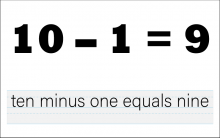
|
Math Clip Art--The Language of Math--Numbers and Equations 25 | Math Clip Art--The Language of Math--Numbers and Equations 25TopicThe Language of Math DescriptionThis image illustrates the equation "10-1=9" in both numerical and word form. It introduces subtraction with a two-digit number, marking a significant step in mathematical understanding. The dual representation of the equation reinforces the connection between mathematical symbols and their verbal expressions. This visual aid is crucial in developing number sense and understanding the concept of subtraction, particularly how removing one from a round number results in a single-digit answer. |
Numerical Expressions |

|
Math Clip Art--The Language of Math--Numbers and Equations 26 | Math Clip Art--The Language of Math--Numbers and Equations 26TopicThe Language of Math DescriptionThis clip art from the Language of Math collection showcases the equation "11-2=9" in both numerical and word formats. It continues the progression of subtraction concepts, now working with larger two-digit numbers. The simultaneous presentation of the equation in symbols and words reinforces the connection between mathematical language and everyday language. This visual representation helps students understand how subtraction works with larger numbers and introduces the concept of "finding the difference" between two numbers. |
Numerical Expressions |
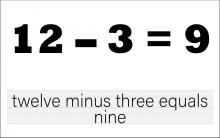
|
Math Clip Art--The Language of Math--Numbers and Equations 27 | Math Clip Art--The Language of Math--Numbers and Equations 27TopicThe Language of Math DescriptionThis image presents the equation "12-3=9" in both numerical and word form. It advances the complexity of subtraction concepts by introducing larger two-digit numbers and a subtrahend greater than 1. The dual representation of the equation reinforces the connection between mathematical symbols and their verbal expressions. This visual aid is crucial in developing number sense and understanding the concept of subtraction, particularly how removing multiple units from a quantity affects the result. |
Numerical Expressions |
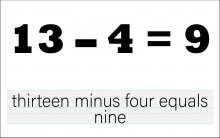
|
Math Clip Art--The Language of Math--Numbers and Equations 28 | Math Clip Art--The Language of Math--Numbers and Equations 28TopicThe Language of Math DescriptionThis clip art from the Language of Math collection illustrates the equation "13-4=9" in both numerical and word form. It continues the progression of subtraction concepts, now working with larger two-digit numbers and a subtrahend greater than 3. The simultaneous presentation of the equation in symbols and words strengthens the connection between mathematical language and everyday language. This visual representation helps students understand how subtraction works with larger numbers and reinforces the concept of "finding the difference" between two numbers. |
Numerical Expressions |
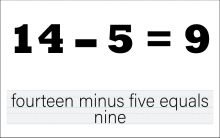
|
Math Clip Art--The Language of Math--Numbers and Equations 29 | Math Clip Art--The Language of Math--Numbers and Equations 29TopicThe Language of Math DescriptionThis image presents the equation "14-5=9" in both numerical and word form. It advances the complexity of subtraction concepts by introducing larger two-digit numbers and a subtrahend of 5. The dual representation of the equation reinforces the connection between mathematical symbols and their verbal expressions. This visual aid is crucial in developing number sense and understanding the concept of subtraction, particularly how removing half of 10 from a teen number results in a single-digit answer. |
Numerical Expressions |
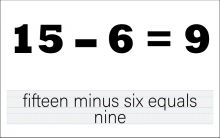
|
Math Clip Art--The Language of Math--Numbers and Equations 30 | Math Clip Art--The Language of Math--Numbers and Equations 30TopicThe Language of Math DescriptionThis clip art from the Language of Math collection showcases the equation "15-6=9" in both numerical and word formats. It continues the progression of subtraction concepts, now working with larger two-digit numbers and a subtrahend greater than 5. |
Numerical Expressions |

|
Math Clip Art--The Language of Math--Numbers and Equations 31 | Math Clip Art--The Language of Math--Numbers and Equations 31TopicThe Language of Math DescriptionThis image illustrates the equation "1*1=1" in both numerical and word form. It introduces the concept of multiplication, starting with the simplest case of multiplying 1 by itself. The dual representation of the equation reinforces the connection between mathematical symbols and their verbal expressions. This visual aid is crucial in developing number sense and understanding the concept of multiplication as repeated addition. |
Numerical Expressions |
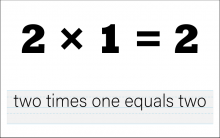
|
Math Clip Art--The Language of Math--Numbers and Equations 32 | Math Clip Art--The Language of Math--Numbers and Equations 32TopicThe Language of Math DescriptionThis clip art from the Language of Math collection showcases the equation "2*1=2" in both numerical and word formats. It continues the introduction of multiplication concepts, now showing multiplication by 1. The simultaneous presentation of the equation in symbols and words reinforces the connection between mathematical language and everyday language. This visual representation helps students understand how multiplication works and introduces the concept of the identity property of multiplication. |
Numerical Expressions |
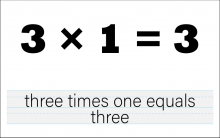
|
Math Clip Art--The Language of Math--Numbers and Equations 33 | Math Clip Art--The Language of Math--Numbers and Equations 33TopicThe Language of Math DescriptionThis image presents the equation "3*1=3" in both numerical and word form. It continues the progression of multiplication concepts, focusing on the multiplication of a single-digit number by 1. The dual representation of the equation reinforces the connection between mathematical symbols and their verbal expressions. This visual aid is crucial in developing number sense and understanding the concept of multiplication, particularly how multiplying by 1 results in the same number. |
Numerical Expressions |

|
Math Clip Art--The Language of Math--Numbers and Equations 34 | Math Clip Art--The Language of Math--Numbers and Equations 34TopicThe Language of Math DescriptionThis clip art from the Language of Math collection illustrates the equation "4*1=4" in both numerical and word form. It continues the progression of multiplication concepts, focusing on the multiplication of a single-digit number by 1. The simultaneous presentation of the equation in symbols and words strengthens the connection between mathematical language and everyday language. This visual representation helps students understand how multiplication works and reinforces the concept of the identity property of multiplication. |
Numerical Expressions |
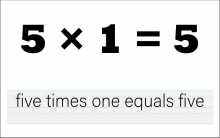
|
Math Clip Art--The Language of Math--Numbers and Equations 35 | Math Clip Art--The Language of Math--Numbers and Equations 35TopicThe Language of Math DescriptionThis image presents the equation "5*1=5" in both numerical and word form. It continues the progression of multiplication concepts, focusing on the multiplication of a single-digit number by 1. The dual representation of the equation reinforces the connection between mathematical symbols and their verbal expressions. This visual aid is crucial in developing number sense and understanding the concept of multiplication, particularly how multiplying by 1 results in the same number. |
Numerical Expressions |

|
Math Clip Art--The Language of Math--Numbers and Equations 36 | Math Clip Art--The Language of Math--Numbers and Equations 36TopicThe Language of Math DescriptionThis clip art from the Language of Math collection showcases the equation "6*2=12" in both numerical and word formats. It advances the complexity of multiplication concepts by introducing multiplication by a number other than 1. The simultaneous presentation of the equation in symbols and words reinforces the connection between mathematical language and everyday language. This visual representation helps students understand how multiplication works with larger numbers and introduces the concept of repeated addition. |
Numerical Expressions |
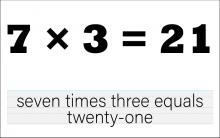
|
Math Clip Art--The Language of Math--Numbers and Equations 37 | Math Clip Art--The Language of Math--Numbers and Equations 37TopicThe Language of Math DescriptionThis image presents the equation "7*3=21" in both numerical and word form. It continues the progression of multiplication concepts, now introducing multiplication with larger single-digit numbers. The dual representation of the equation reinforces the connection between mathematical symbols and their verbal expressions. This visual aid is crucial in developing number sense and understanding the concept of multiplication, particularly how it relates to repeated addition and grouping. |
Numerical Expressions |
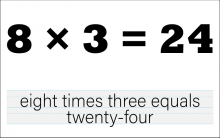
|
Math Clip Art--The Language of Math--Numbers and Equations 38 | Math Clip Art--The Language of Math--Numbers and Equations 38TopicThe Language of Math DescriptionThis clip art from the Language of Math collection illustrates the equation "8*3=24" in both numerical and word form. It continues the progression of multiplication concepts, focusing on multiplication with larger single-digit numbers. The simultaneous presentation of the equation in symbols and words strengthens the connection between mathematical language and everyday language. This visual representation helps students understand how multiplication works with larger numbers and reinforces the concept of repeated addition and grouping. |
Numerical Expressions |
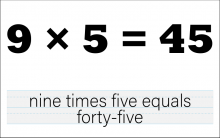
|
Math Clip Art--The Language of Math--Numbers and Equations 39 | Math Clip Art--The Language of Math--Numbers and Equations 39TopicThe Language of Math DescriptionThis image presents the equation "9*5=45" in both numerical and word form. It advances the complexity of multiplication concepts by introducing larger single-digit numbers and a product greater than 40. The dual representation of the equation reinforces the connection between mathematical symbols and their verbal expressions. This visual aid is crucial in developing number sense and understanding the concept of multiplication, particularly how it relates to repeated addition and grouping with larger numbers. |
Numerical Expressions |

|
Math Clip Art--The Language of Math--Numbers and Equations 40 | Math Clip Art--The Language of Math--Numbers and Equations 40TopicThe Language of Math DescriptionThis clip art from the Language of Math collection illustrates the equation "10*2=20" in both numerical and word form. It introduces multiplication with a two-digit number, marking a significant step in mathematical understanding. The simultaneous presentation of the equation in symbols and words strengthens the connection between mathematical language and everyday language. This visual representation helps students understand how multiplication works with larger numbers and reinforces the concept of repeated addition and grouping. |
Numerical Expressions |
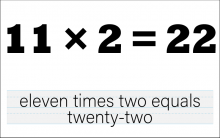
|
Math Clip Art--The Language of Math--Numbers and Equations 41 | Math Clip Art--The Language of Math--Numbers and Equations 41TopicThe Language of Math DescriptionThis image presents the equation "11*2=22" in both numerical and word form. It continues the progression of multiplication concepts, now working with two-digit numbers. The dual representation of the equation reinforces the connection between mathematical symbols and their verbal expressions. This visual aid is crucial in developing number sense and understanding the concept of multiplication, particularly how it relates to repeated addition and grouping with larger numbers. |
Numerical Expressions |

|
Math Clip Art--The Language of Math--Numbers and Equations 42 | Math Clip Art--The Language of Math--Numbers and Equations 42TopicThe Language of Math DescriptionThis clip art from the Language of Math collection illustrates the equation "12*3=36" in both numerical and word form. It advances the complexity of multiplication concepts by introducing larger two-digit numbers and a product greater than 30. The simultaneous presentation of the equation in symbols and words strengthens the connection between mathematical language and everyday language. This visual representation helps students understand how multiplication works with larger numbers and reinforces the concept of repeated addition and grouping. |
Numerical Expressions |
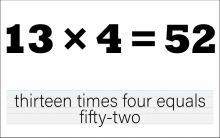
|
Math Clip Art--The Language of Math--Numbers and Equations 43 | Math Clip Art--The Language of Math--Numbers and Equations 43TopicThe Language of Math DescriptionThis image presents the equation "13*4=52" in both numerical and word form. It continues the progression of multiplication concepts, now working with larger two-digit numbers and a product greater than 50. The dual representation of the equation reinforces the connection between mathematical symbols and their verbal expressions. This visual aid is crucial in developing number sense and understanding the concept of multiplication, particularly how it relates to repeated addition and grouping with larger numbers. |
Numerical Expressions |
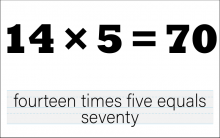
|
Math Clip Art--The Language of Math--Numbers and Equations 44 | Math Clip Art--The Language of Math--Numbers and Equations 44TopicThe Language of Math DescriptionThis clip art from the Language of Math collection illustrates the equation "14*5=70" in both numerical and word form. It advances the complexity of multiplication concepts by introducing larger two-digit numbers and a product reaching 70. The simultaneous presentation of the equation in symbols and words strengthens the connection between mathematical language and everyday language. This visual representation helps students understand how multiplication works with larger numbers and reinforces the concept of repeated addition and grouping. |
Numerical Expressions |
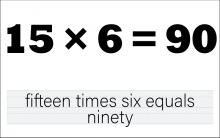
|
Math Clip Art--The Language of Math--Numbers and Equations 45 | Math Clip Art--The Language of Math--Numbers and Equations 45TopicThe Language of Math DescriptionThis image presents the equation "15*6=90" in both numerical and word form. It continues the progression of multiplication concepts, now working with larger two-digit numbers and a product reaching 90. The dual representation of the equation reinforces the connection between mathematical symbols and their verbal expressions. This visual aid is crucial in developing number sense and understanding the concept of multiplication, particularly how it relates to repeated addition and grouping with larger numbers. |
Numerical Expressions |

|
Math Clip Art--The Language of Math--Numbers and Equations 46 | Math Clip Art--The Language of Math--Numbers and Equations 46TopicThe Language of Math DescriptionThis clip art from the Language of Math collection illustrates the equation "1/1=1" in both numerical and word form. It introduces the concept of division, starting with the simplest case of dividing a number by itself. The simultaneous presentation of the equation in symbols and words strengthens the connection between mathematical language and everyday language. This visual representation helps students understand the basic concept of division and introduces the idea that any number divided by itself equals 1. |
Numerical Expressions |

|
Math Clip Art--The Language of Math--Numbers and Equations 47 | Math Clip Art--The Language of Math--Numbers and Equations 47TopicThe Language of Math DescriptionThis image presents the equation "2/2=1" in both numerical and word form. It continues the progression of division concepts, now working with a fraction where the numerator and denominator are equal. The dual representation of the equation reinforces the connection between mathematical symbols and their verbal expressions. This visual aid is crucial in developing number sense and understanding the concept of division, particularly how dividing a number by itself always results in 1. |
Numerical Expressions |

|
Math Clip Art--The Language of Math--Numbers and Equations 48 | Math Clip Art--The Language of Math--Numbers and Equations 48TopicThe Language of Math DescriptionThis clip art from the Language of Math collection illustrates the equation "3/3=1" in both numerical and word form. It continues the series of division concepts, focusing on fractions where the numerator and denominator are equal. The simultaneous presentation of the equation in symbols and words strengthens the connection between mathematical language and everyday language. This visual representation helps students understand how division works and reinforces the concept that any number divided by itself equals 1. |
Numerical Expressions |